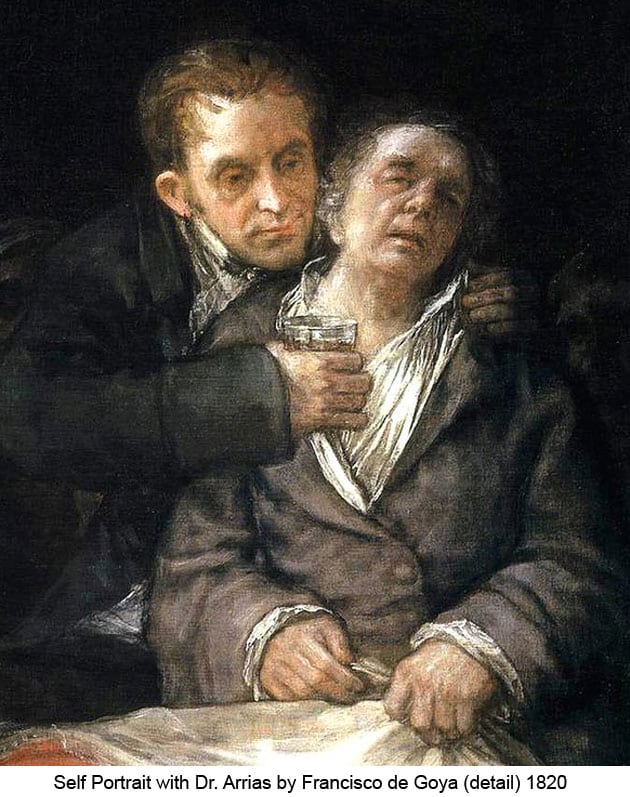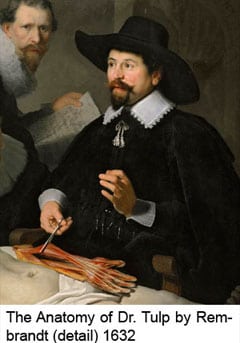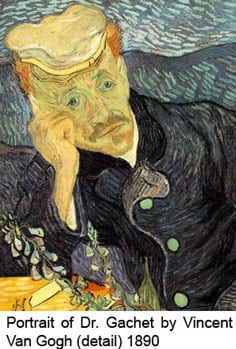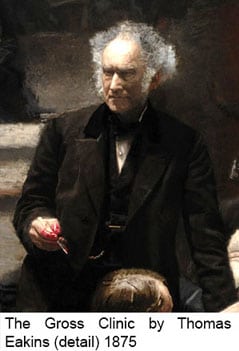
I recently went to Boston to see the Goya exhibit at the Boston Museum of Fine Arts, and was thrilled to see one of my favorite paintings by this artist – Self Portrait with Dr. Arrias. The painting was on loan from the Minneapolis Institute of Arts – a museum I never had the chance to visit. In my opinion this is one of the best portraits of a physician in the history of western art in the way it shows deep compassion and a fierce will to improve the health of his patient.
 This oil painting was created in 1820 when the artist was 74, and 8 years before his death. The artist had already achieved great fame as painter to royal courts of Spain. Goya had been afflicted for years with medical problems that left him deaf and partially blind. The nature of his illness remains a mystery, but some conjecture that it might have been due to lead poisoning from his paints.
This oil painting was created in 1820 when the artist was 74, and 8 years before his death. The artist had already achieved great fame as painter to royal courts of Spain. Goya had been afflicted for years with medical problems that left him deaf and partially blind. The nature of his illness remains a mystery, but some conjecture that it might have been due to lead poisoning from his paints.
The painting shows Dr. Arrias holding a pale and weakened Goya as he administers what might be his medicine. The positioning and gesture of the hands of the doctor express a determination to get his patient better, and his face expresses kindness and caring. In the background are mysterious dark figures that might represent the nightmares of a man in a state of delirium. After this painting was executed Goya began work on his “Black Paintings” which greatly expanded his dark visions of humanity.
 This portrait reveals its greatness when compared with other portraits of physicians done by famous artists. Dr. Tulp, for example, painted by Rembrandt van Rijn in 1632 shows a flamboyantly dressed professor teaching anatomy to a group of students. The design of this portrait does not reflect caring for a sick patient, but rather exhibits a pedantic scientific demonstration.
This portrait reveals its greatness when compared with other portraits of physicians done by famous artists. Dr. Tulp, for example, painted by Rembrandt van Rijn in 1632 shows a flamboyantly dressed professor teaching anatomy to a group of students. The design of this portrait does not reflect caring for a sick patient, but rather exhibits a pedantic scientific demonstration.
The portrait of Dr. Gachet painted by Vincent Van Gogh in 1890 depicts a man who appears melancholy or bored, leaning his head against his hand. In front of him are two novels and a foxglove plant, from which digitalis is extracted. There is no indication that the subject is a physician other than the medicinal plant in front of him and Van Gogh’s letters, and there is no display of caring or compassion that comes across.
 Then there is the great portrait of Dr. Gross by Thomas Eakins, painted in 1875. In this painting the doctor with bloody hand and scalpel is looking away from a patient who is unconscious on the operating table and whose leg is being cut. To the viewer’s left and behind Dr. Gross is a person in distress, possibly the patient’s mother, and the great doctor shows no reaction or empathy. Dr. Gross might have been a skilled surgeon and teacher, but compassion does not seem his forté, at least in this portrait.
Then there is the great portrait of Dr. Gross by Thomas Eakins, painted in 1875. In this painting the doctor with bloody hand and scalpel is looking away from a patient who is unconscious on the operating table and whose leg is being cut. To the viewer’s left and behind Dr. Gross is a person in distress, possibly the patient’s mother, and the great doctor shows no reaction or empathy. Dr. Gross might have been a skilled surgeon and teacher, but compassion does not seem his forté, at least in this portrait.
When we compare Goya’s image to these paintings, we begin to appreciate the qualities that are displayed in Dr. Arrias through the artist’s skilled hand. The attributes of compassion and caring are difficult to measure in board examinations, and may not matter much in today’s data driven healthcare environment. Yet these qualities are so important in establishing a relationship with a sick patient. The process of entering a physician-patient relationship is an intimate, challenging experience that should not be taken for granted, and we as physicians have the ability to change people’s lives. In Dr. Arrias’ case, he enabled Goya to live another 8 years and further express his genius in art, which was a gift to the world. Perhaps this painting needs to be distributed to every medical student as the ideal to be attained through training as a physician.
* * * * * * * * * * * * * *
References for this post include:
Aronson JK, Ramachandran M. The diagnosis of art: melancholy and the Portrait of Dr Gachet, J R Soc Med. Jul 2006; 99(7): 373–374.
Park MP, Park RHR. The fine art of patient-doctor relationships. BMJ. Dec 18, 2004; 329(7480): 1475–1480.
Felisati D, Sperati G. Francisco Goya and his illness. Acta Otorhinolaryngol Ital. Oct 5, 2010; 30(5): 264–270.
Related posts:
JAMA is Redesigned, Art is Demoted
Caring on the Cover of The Gerontologist
Arion Triumphant
Wounds of a Boxer: Medical Secrets from Ancient Rome
Visiting Doctor Chekhov
Painting, Poetry, and Medicine: Charles Demuth and William Carlos Williams
A Taste of Ancient Peruvian Medicine
Geriatrics, Humanistic Medicine, & Art
.
